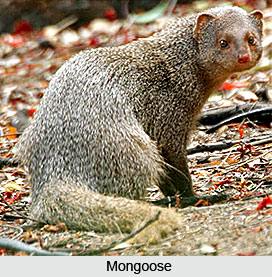 Mongoose is a terrestrial, active, bold and predaceous animal, well known for its fight with shakes. A single genus, herpestes, occurs in the subcontinent. Two species, H. auropunctatus and H. edwardsi, are widely distributed in the region whereas the Ruddy Mongoose (H.smithi), which is distinguished by the black tip to its tail, is found from Rajasthan to Sri Lanka in the south and up to Bengal in the east. The Brown (H. fuscus) and Striped-necked (H. vitticollis) Mongoose inhabit southern India and Sri Lanka. The large Crab-eating Mongoose, H. urva, is distributed throughout Bangladesh, Nepal and the Assam region, its range extending to southern China, Thailand and Taiwan.
Mongoose is a terrestrial, active, bold and predaceous animal, well known for its fight with shakes. A single genus, herpestes, occurs in the subcontinent. Two species, H. auropunctatus and H. edwardsi, are widely distributed in the region whereas the Ruddy Mongoose (H.smithi), which is distinguished by the black tip to its tail, is found from Rajasthan to Sri Lanka in the south and up to Bengal in the east. The Brown (H. fuscus) and Striped-necked (H. vitticollis) Mongoose inhabit southern India and Sri Lanka. The large Crab-eating Mongoose, H. urva, is distributed throughout Bangladesh, Nepal and the Assam region, its range extending to southern China, Thailand and Taiwan.
Mongoose is diurnal except when it resides very close to villages or in the outskirts of towns. The animal is very adaptable and occurs in a variety of habitats from desert to cultivated croplands and light scrub forest. It lives in burrows, in man-made drains, culverts, and in ruined buildings. It can freely climb threes and swim easily. Most of the mongoose species mark their territory with the secretion from their anal gland. When attacked or cornered the animal erects its long hair and fight rather fiercely. Mongoose consumes a variety of food, principally insects, centipedes, scorpions, frogs, toads, snakes and lizards, and birds and their eggs, and rodents. It feeds on carrion also and is frequently observed feeding on fruits and other parts of plants. In spite of the fact that the mongoose is fairly common, very little is known about its breeding habits. Most of the species breed all the year round and the litter size varies from one to three, the gestation period being forty to sixty days. A captive female H. edwardsi produced five litters during eighteen months. Sexual maturity is attained by the mongoose at the age of eight to nine months. The mother becomes very fierce before and after parturition. Their life-span varies from seven up to thirteen years for the larger species.
This article is a stub. You can enrich by adding more information to it. Send your Write Up to content@indianetzone.com



















